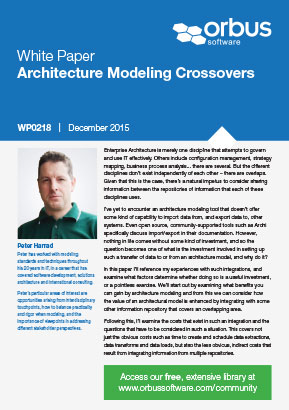In this paper I’ll reference my experiences with such integrations, and examine what factors determine whether doing so is a useful investment, or a pointless exercise. We’ll start out by examining what benefits you can gain by architecture modeling, follow on with examination of the costs that exist in such an integration, and finish off by examining five common examples.
Enterprise Architecture is merely one discipline that attempts to govern and use IT effectively. Others include configuration management, strategy mapping, business process analysis... there are several. But the different disciplines don’t exist independently of each other – there are overlaps. Given that this is the case, there’s a natural impetus to consider sharing information between the repositories of information that each of these disciplines uses.
’ve yet to encounter an architecture modeling tool that doesn’t offer some kind of capability to import data from, and export data to, other systems. Even open source, community-supported tools such as Archi specifically discuss import/export in their documentation. However, nothing in life comes without some kind of investment, and so the question becomes one of what is the investment involved in setting up such a transfer of data to or from an architecture model, and why do it?
In this paper I’ll reference my experiences with such integrations, and examine what factors determine whether doing so is a useful investment, or a pointless exercise. We’ll start out by examining what benefits you can gain by architecture modeling and from this we can consider how the value of an architectural model is enhanced by integrating with some other information repository that covers an overlapping area.
Following this, I’ll examine the costs that exist in such an integration and the questions that have to be considered in such a situation. This covers not just the obvious costs such as time to create and schedule data extractions, data transforms and data loads, but also the less obvious, indirect costs that result from integrating information from multiple repositories.
Login to continue reading thie ebook.
